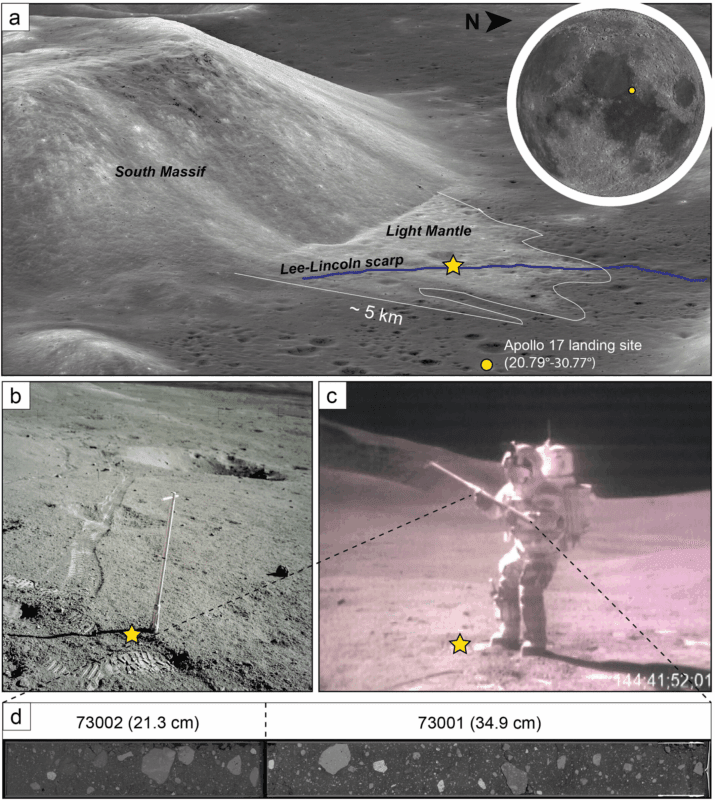Back in December 1972, the Apollo 17 mission marked the end of NASA’s human-led ventures to the Moon. This historic journey brought back a wealth of cosmic treasures, notably pieces from the mystifying “Light Mantle”—a rare and brightly colored deposit nestled at the foot of the South Massif in the Taurus-Littrow Valley. Believe it or not, these lunar samples, which were stashed away for over fifty years, have recently been dusted off for a deeper analysis thanks to the Apollo Next Generation Sample Analysis (ANGSA) Program. This program employs cutting-edge technology to unravel lunar enigmas, gearing us up for upcoming missions, such as NASA’s Artemis expedition, which is set to land astronauts back on the Moon soon.
The “Light Mantle” sparks curiosity among scientists due to its striking reflectiveness, though the source of this peculiar material remains an open question. Recent investigations, as detailed in studies featured in the Journal of Geophysical Research: Planets, are utilizing advanced methods like micro-CT scanning to probe its origins and characteristics.
Unraveling the Geological Mystery of the Light Mantle
The unusual nature of the Light Mantle has led to several theories regarding how it came to be. One of the prominent ideas suggests it might be the fallout from the Tycho impact, a colossal event that formed the impressive Tycho Crater, which spans 85 kilometers. The Moon’s surface is peppered with craters, but Tycho is distinctive with its prominent rays that scatter across the terrain, reaching sites like the South Massif where the Light Mantle resides.
In a recent study, lead researcher Dr. Giulia Magnarini, affiliated with the Natural History Museum in London, emphasized that the origins of the Light Mantle remain hotly debated. “Some theories propose it could have formed from ejecta from the Tycho impact; or could have been materials from the South Massif moved around by Tycho’s impact events; and then there are ideas suggesting possible landslide material linked to the seismic activity of the Lee-Lincoln fault in the Taurus-Littrow Valley,” Dr. Magnarini noted. This collection of theories illustrates the rich complexity of geological forces involved, with experts still searching for clarity on which events—or combo of them—made the Light Mantle what it is today.
Moreover, there’s a hypothesis suggesting that a landslide might also be behind the formation of this unique layer. According to Dr. Magnarini, the region shows signs indicative of long-runout landslides—a phenomenon that’s known on both Earth and Mars, but remains essentially unique to the Moon. “I’ve studied different types of long-runout landslides here at home and even on Mars. But the Light Mantle is currently the only known example on the Moon,” she highlighted. “We still don’t fully grasp how these lunar landslides occurred or what propelled debris to extend over such long distances.” This theory posits that seismic actions, possibly stirred up by impacts like the one from Tycho, may have allowed materials from the South Massif to be dispersed far and wide, contributing to the Light Mantle.
Game-Changing Sample Analysis Using Modern Tech
One of the coolest advancements in studying theselunar samples lies in implementing state-of-the-art scanning technology. Back when the Apollo samples landed on Earth, we lacked the sophisticated scanning tools to closely examine these lunar wonders. Today’s micro-CT scanning technologies, which also work wonders in the medical field, make it possible for scientists to analyze the samples in astonishing detail. This high-tech approach is vital for comprehending the internal structures and the genesis of these lunar rocks.
Dr. Magnarini lauded NASA’s foresight in preserving these samples for the future. “NASA really outdid themselves during the Apollo missions by setting some samples aside for advanced study later on,” she pointed out. “They ensured that these specimens could be looked at with newer technologies and techniques that were not even on our radar back then.” This thoughtful planning is paying dividends today, allowing researchers to peel back layers of mysteries that were previous shrouded in obscurity.
A pivotal finding from this investigation has been the identification of “clasts”—rock fragments that broke off from their main bodies. Many of these clasts appear to have come from the South Massif, offering vital insights into the process behind these landslide formations. As Dr. Magnarini explained, the fine material loyal to the clasts indicates how the landslide functioned. “These fragments provide deep insight into the landslide process and how the material moved. Observing how the finer particles that cover the clasts originate from the debris reveals that the clasts shattered and got the slide flowing more like a liquid,” she elaborated. This understanding could lead us to quicker insights into how elements on the Moon traverse vast distances, especially given its barren atmosphere and lack of water to assist movement.
Impact on Upcoming Lunar Missions and the Artemis Initiative
Reviving the study of Apollo 17 samples signifies not just a scientific leap forward but also represents a keystone in mapping out future lunar explorations. Insights lifted from these samples are critical for refining the subsequent missions, including NASA’s Artemis program, targeting to have astronauts touch down on the Moon in 2027. As NASA edges closer to groundbreaking lunar studies, the Apollo Next Generation Sample Analysis (ANGSA) Program is set to play an essential role in these efforts.
According to NASA, “The goal of the Apollo Next Generation Sample Analysis (ANGSA) Program is to squeeze the maximum science out of the Apollo samples, all while prepping for lunar missions we can expect during this decade and the future.”






















